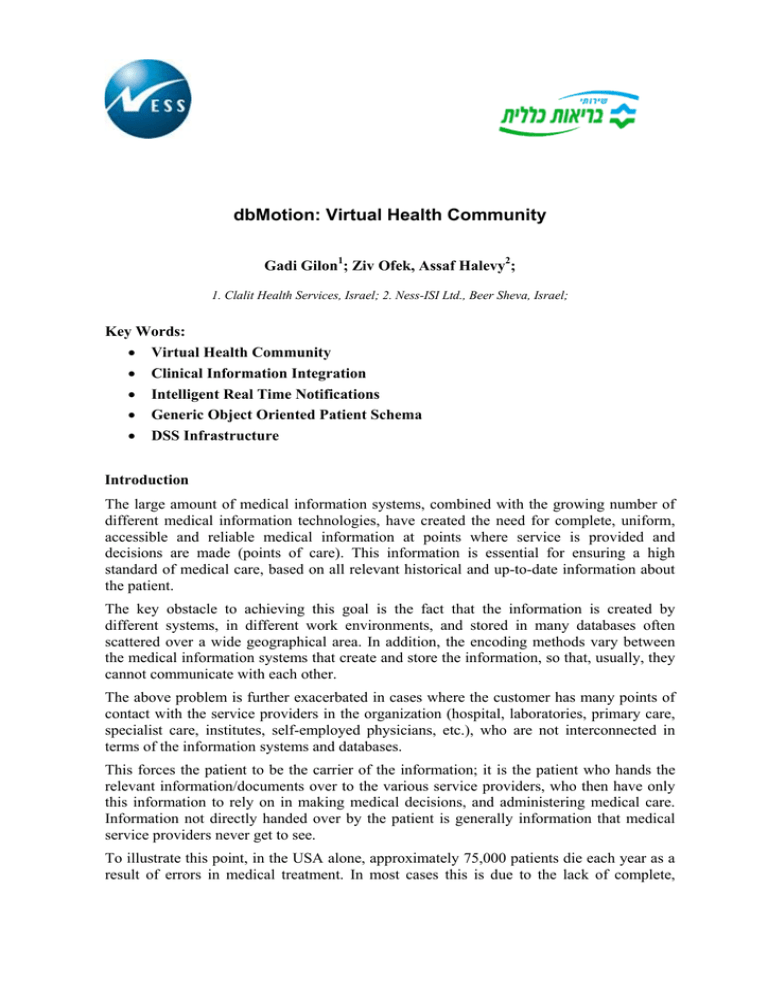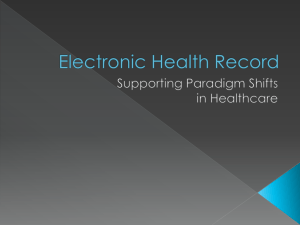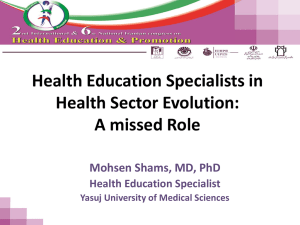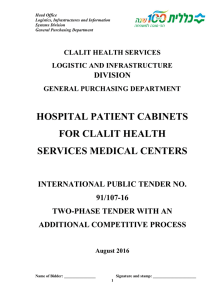dbMotion: Virtual Health Community
advertisement

dbMotion: Virtual Health Community Gadi Gilon1; Ziv Ofek, Assaf Halevy2; 1. Clalit Health Services, Israel; 2. Ness-ISI Ltd., Beer Sheva, Israel; Key Words: • Virtual Health Community • Clinical Information Integration • Intelligent Real Time Notifications • Generic Object Oriented Patient Schema • DSS Infrastructure Introduction The large amount of medical information systems, combined with the growing number of different medical information technologies, have created the need for complete, uniform, accessible and reliable medical information at points where service is provided and decisions are made (points of care). This information is essential for ensuring a high standard of medical care, based on all relevant historical and up-to-date information about the patient. The key obstacle to achieving this goal is the fact that the information is created by different systems, in different work environments, and stored in many databases often scattered over a wide geographical area. In addition, the encoding methods vary between the medical information systems that create and store the information, so that, usually, they cannot communicate with each other. The above problem is further exacerbated in cases where the customer has many points of contact with the service providers in the organization (hospital, laboratories, primary care, specialist care, institutes, self-employed physicians, etc.), who are not interconnected in terms of the information systems and databases. This forces the patient to be the carrier of the information; it is the patient who hands the relevant information/documents over to the various service providers, who then have only this information to rely on in making medical decisions, and administering medical care. Information not directly handed over by the patient is generally information that medical service providers never get to see. To illustrate this point, in the USA alone, approximately 75,000 patients die each year as a result of errors in medical treatment. In most cases this is due to the lack of complete, available and reliable information, as well as to the lack of medical tracking, and poor communications between physicians. The present situation, and the aforesaid problems, indicates an urgent need for a comprehensive computerized architecture, capable of interconnecting heterogeneous medical information systems, and creating a virtual homogenous environment, in which complete, reliable and qualitative information is available to the service provider at the point of care, at the right time. This is precisely the goal that the dbMotion system achieves. Meeting the Market Demands The amounts of client data accumulated, especially in the medical area, is increasing rapidly every year. The data is stored in a variety of different applications or systems within departments or organizations that are physically dispersed and remote. Such large organizations need to provide their clients with the best medical care and service while avoiding diagnostic mistakes and double-testing. These errors can result in the spending of millions of dollars, due to lack of available, up-to-date information. Hence, there is a need for a unified, logical infrastructure that will make it possible for all important information about a client to be accessible from any point in the organization. The dbMotion platform provides a state of the art breakthrough in this area. The system collects information from various data sources, held on a variety of applications, and located in various branches, clinics and even countries, without the need to establish a centralized database. The dbMotion system induces a “quiet evolution” in the organization, bringing it to a new era without causing major changes to existing systems or infrastructure. Organizations benefit from comprehensive, unified, pan-enterprise information while they can continue using their existing operational systems. This happens without disruption of day-to-day operations. Business Challenge The healthcare IT (HCIT) industry has its roots in “product-centric” vertical software development; as administrative, financial or basic clinical needs were identified, standalone applications were developed to address them individually. This vertical application approach has been implemented to such an extent today, that on average, US hospitals have more than thirty distinct information systems, handling information for disparate departments and divisions. Since each application is designed with different structures, codes and protocols, the result is that currently, fewer than 25 percent of these systems are able to share medical information with each other, and patient caregivers continue to struggle with inefficiencies stemming from the silos of irretrievable information caused by disparate legacy systems. The result is: • Wasted Time. Large amounts of time is consumed by physicians and their assistants on tasks such as locating charts, searching for specific clinical information, following-up on consultations, making phone calls to get results and/or tracking down a nurse to get information, either inside or outside the hospital. dbMotion – Virutal Health Community dbMotion@ness-isi.com • Wasted Money. Unnecessary testing and procedures contributes to billions of wasted healthcare dollars every year. • Reduced Quality of Care. Doctors may prescribe a drug that is not appropriate for a particular patient without realizing that the patient is allergic to the drug, or prescribe a therapy that is less effective than another option. In addition, emergency cases in the ER may be delayed due to inaccessible lab results that are stored in legacy systems at a hospital. Market forces such as mergers and acquisitions, government regulation (HIPAA in the US, and the European Privacy Standards), decentralization and globalisation, are forcing the HCIT landscape to change and to create a “patient-centric” environment that emphasizes the need for information sharing more than ever before. The healthcare industry worldwide strives for advanced information technologies that will restructure inefficient data collection from modes that “collect many times, use once”, to a “collect once, use many times” arrangement. It is difficult, on the other hand, to circulate information within a large and decentralized organization. Even if the entire organization works within just one building, each department may work independently and produce its own data on the same subject. Moreover, many enterprises consist of several geographically remote units or branches, with little exchange of critical information between them. For example, a local hospital may generate, over time, a file that contains critical medical information on a patient. When that patient has to be treated in a different hospital, all the information has to be gathered again. In this case, although the two hospitals may not belong to the same health fund or area, they do belong to the same enterprise: national healthcare. dbMotion solves these issues, and even allows different healthcare organizations in different countries to share information seamlessly. dbMotion is not just one application, it is a versatile collection of modules and network components, which work together in seamless synchronization. Together, they form a comprehensive system for processing and sharing information throughout the organization, and across organizational barriers. The dbMotion Overview The principle underpinning the dbMotion Virtual Health Community is as follows: The Community is a virtual collection of members (hospitals, districts, institutes, labs, etc.) in which all of the information stays in the same place and format that it was created (in each member). The uniqueness of the system is in its capacity to gather information on demand, from all of the information systems dispersed in the organization, to unite the information into a single "package", and to transfer it within seconds to the service provider at the Point of Care. This offers the service provider an up-to-date, reliable and complete picture of the relevant information for making decisions, and providing effective medical care at very high standards. The dbMotion system is an innovative and advanced n-tier application, which is derived from knowledge and experience in the development of complex multi-user Internet dbMotion – Virutal Health Community dbMotion@ness-isi.com systems. The system was built using new technology, and conforms to all the standards and requirements expected of these types of systems for: performance, robustness, userinterface, extremely strict information security (using advanced methods for applying authorization, authentication, encryption etc.), and more. The dbMotion platform enables the design, implementation, operation and management of a web-based Virtual Health Community. dbMotion enables online gathering of medical information components from different, distributed sources, and their transfer within seconds to authorized users according to different usage profiles. dbMotion also has a unique mechanism for supporting DSS (Decision Support Systems). dbMotion is also an advanced Web-based medical information environment, combining sets of exclusive methodologies and tools for managing all the medical information lifecycle. This includes: • On-line retrieval of the patient’s clinical data from decentralized diverse clinical databases • Intelligent Real Time Notification (IRTN) provides predefined alerts and notifications to your SMS, email, or browser. Instead of looking for the information you need, it will look for you • Data mapping and conversion, merging of data sources • Web-based viewing information engine • Monitoring and control of information traffic • Aligned with the security, confidentiality, and user authentication of the organisation The dbMotion product includes a viewer which is an innovative web-based system, based on the dbMotion platform that enables the care provider to browse through the patient history. One of dbMotion’s greatest strengths is that it supports Wireless LAN while using mobile platforms, such as the Tablet PC, at Point-of-Care. The dbMotion Intelligent Real Time Notification (IRTN) intelligently draws conclusions out of raw data, and then creates Alerts and Notifications. Notifications are provided to the user in a push manner upon subscribing to an event. Additionally, IRTN is capable of triggering an event based on the rules of another event. The unique approach of monitoring events over distributed geographical locations creates a wide range of new possibilities to improve quality of care and ROI. Case Study: Implementation in Clalit Health Services Client : Clalit Health Services, Israel Industry : Healthcare Management Organizations Key Solution : Virtual Health Community Key Benefit : Improving the quality of care, lower costs. Region: Israel Background Clalit Health Services is the largest health organization in Israel and the second largest in the world. It is a decentralized organization that provides services to approximately 3.7 dbMotion – Virutal Health Community dbMotion@ness-isi.com million clients through 14 hospitals, 1,300 clinics and medical centres. The organization employs approximately 20,000 care providers, each of which can create medical data and, more importantly, request up-to-date data about patients. The medical information systems in the organization differ from one another and lack unification between the systems. The dbMotion system is currently installed at all Clalit hospitals, and in some specialty hospitals. The system is also in use at in all the districts and clinics. Since the system is Intranet-based, it is accessible to any service or care provider for whom an account has been defined in the organizational network. The Solution The dbMotion solution, implemented at Clalit, was based on the requirement to collect data from the existing legacy systems without the need to replace them, change their function or the way they are utilized. dbMotion integrates data from clinical sources that are dispersed geographically all throughout the Clalit, and contain various types of information. For example, the solution integrates data from the hospital Emergency Room and wards, the local clinics, as well as the several Clalit laboratories. In addition, the solution needed to utilize existing infrastructures for communication and data transfer such as the LAN and WAN networks or the Internet, as well as a web-based viewer, where the physician can browse through his patient's history. The solution provides available, up-to-date medical information while maintaining the highest level of information security. In addition, the solution provides the combination of clinical guidelines collected by the system for decision support and is capable of connecting the user to various databases. Dr Yaari, Using dbMotion on a Wireless Tablet PC at Point-of-Care The Results The dbMotion solution is operational in “Clalit Health Services” for the last 30 months, and is installed in most of Clalit Health Services’ hospitals (14 hospitals) and in most districts (each district controls clinics, labs and institutes – 8 districts, more than 1,300 clinics and 8,300GPs) constantly grows and provides up-to-date information at the point of care. The dbMotion – Virutal Health Community dbMotion@ness-isi.com system has thousands of users and millions of hits and has required minimal investment in training and implementation. The solution has contributed to the efficiency of processes and to the improvement in quality and availability of medical information. The system has reduced the general concern regarding medical negligence due to the lack of available information. In addition, the system saves major costs by preventing “doubletesting” and unnecessary procedures, which were previously done, due to lack of cross site up-to-date information. The adoption of the system has been extremely easy and consequently the number of users grew from a few dozen to thousands in a matter few months. The Customer Value Proposition Stated below, are the highlights of the added value that dbMotion provides to the customer: • Fully-integrated clinical picture given to the care provider in near real-time. • Single point of access to distributed and diverse existing data systems • Supports the model of the unified patient medical object, including infrastructures for data input into the patient's record from every medical facility. • Easy access to all the relevant clinical information for treating patients • Profile-based security model gives the ability to allow different users at different authorization levels access to different types of data, varying historical depths, different methods of presentation, etc • Flexible data views with the ability to choose to display only the local hospital system or opt for online display of all the major medical centres and hospitals without the need to create a single, central repository. • Improving comprehensive information flows from disparate legacy systems will significantly increase the quality of care and may lead to early detection of disease, rapid treatment response time and overall cost savings in the long run. • Monitoring and tracking capabilities allows an organization to observe and trace everything a user is doing in the system, in a very high resolution. The system can follow and record what clinical subjects were viewed, by whom, from what machine, when, if something was printed, how long the information was viewed, under what permissions, etc. • Supports the medical decision-making process with Rule-Based CAI and, ultimately, improves the quality of medical care provided to the patient. Financial Benefits Gained IT Cost Benefits The ability to continue the use of existing operational systems, applications and infrastructure combined with increased user functionality and capability means dbMotion comes at a relatively low cost compared with the cost of replacing all existing systems. (Clalit still uses about 5-10 old central systems). The dbMotion solution is implemented with minor client end installation costs since it is based on a Web browser user interface. This can help minimize the installation and ongoing maintenance/support costs. The dbMotion – Virutal Health Community dbMotion@ness-isi.com utilization of existing global networks such as the Internet can eliminate the need to purchase new equipment. Patient Care Cost Benefits Today, when patients pass from one doctor to another or from one department to another in the hospital, results of the lab tests they underwent often fail to reach the new doctor or department. This means the tests have to be performed all over again. Even if the percentage of the double-tests avoided reaches only one or two percent of all tests performed, it still saves enormous costs. The average number of lab tests performed in a typical Clalit general hospital is about 1.25 million per year; Clalit Health Services operates eight general hospitals and six specialized hospitals, so that even at a minimal cost of $10 per test (and only at the general hospitals), the organization saves one million dollars every year. It is important to note that this does not include regional clinics; there the situation is even more critical since patients visit some hospitals and switch from doctor to doctor regularly. dbMotion – Virutal Health Community dbMotion@ness-isi.com






